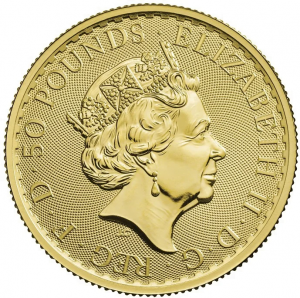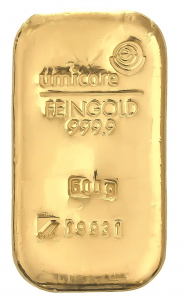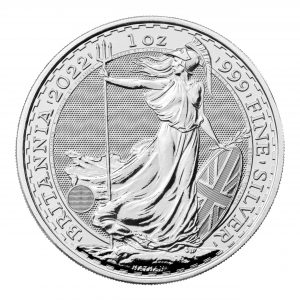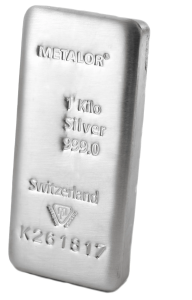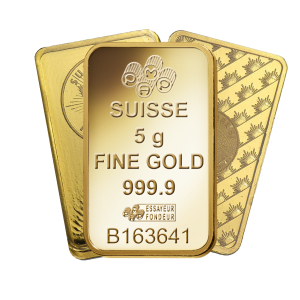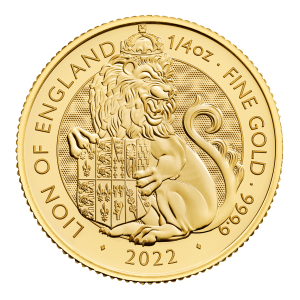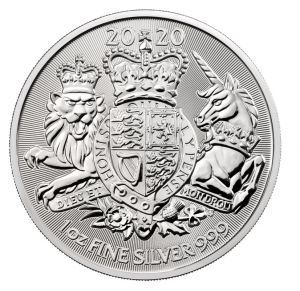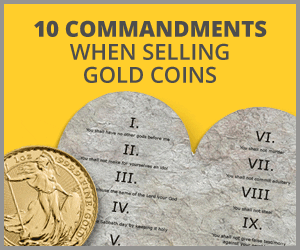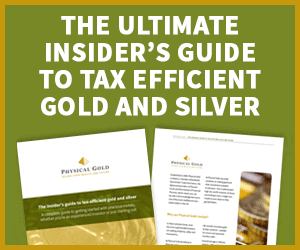The silver Britannia is an iconic British coin introduced by the Royal Mint. These are 1oz coins minted by The Royal Mint to a purity of 999.9 silver. They were first issued in 1997, 10 years after the gold 1oz Britannia, and have become a very popular choice for physical silver investors. They can be bought at relatively low prices as they’re minted to bullion standard and large numbers. They have a face value of £2 which means they’re legal tender and therefore any rise in value is free from Capital Gains Tax.
In 1987, the Royal Mint introduced the gold Britannia coin. The coin enjoyed popularity amongst investors and the silver Britannia was introduced into the market to replicate the success of its gold counterpart. Although the coin was upgraded to 24-carat silver with a fineness of 99.9% in 2013, the original issue had a fineness of 95.8%. The Royal Mint wanted to create a replica of the gold Britannia in silver.
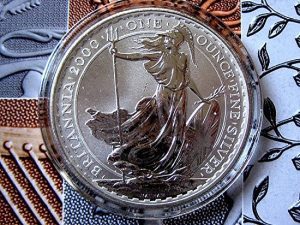
The beautiful Silver Britannia, designed by Jody Clark
The design of the silver Britannia
The silver coin was expected to mirror its gold counterpart in terms of look and feel. So, the well-known coin designer, Jody Clark was commissioned to do the job. The design of the silver Britannia features the image of Britannia, holding her shield and trident. It is now thought that this image originated during Roman times and depicted the spirit and bravery of the British people. The coin portrays the warrior goddess on its reverse and features an image of Queen Elizabeth the second, the longest-reigning British monarch on the coin’s obverse. The upgrade of the fineness of the coin in 2013, increased the demand for the silver Britannia. Importantly, the coin offered investors an avenue to get into the precious metals market at a lower price point than purchasing gold coins.
Advantages of buying the silver Britannia
The bullion version of the coin carries low premiums since the coin was introduced recently. However, commemorative issues and collectable editions of the coin can attract higher premiums. Availability and affordability are the two pillars that have contributed to the popularity of the silver Britannia. In March 2020, the gold-silver ratio touched an astonishing 125:1. Since then, there have been changes to this ratio, but the price difference between the purchase of the gold Britannia and the silver Britannia has encouraged investors to buy this coin.
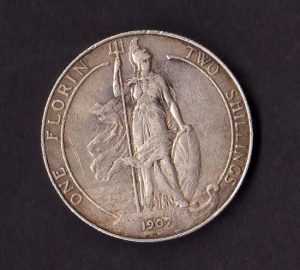
The image of Britannia has been used earlier in British coinage, like this Edward VII Florin
Tax efficiency
In addition to the advantages offered by the low price of silver, when compared to gold, the silver Britannia is a legal tender coin. In the UK, this means investors can book profits on the sale of this coin, without having to pay Capital Gains Tax (CGT). This exemption can ensure tax-free profits within a single tax year for many investors. The silver Britannia is an excellent coin to purchase, due to its advantages as a tax haven.
Download the 7 Crucial Considerations before you buy Silver and Gold. Click here.
Divisibility and liquidity
The silver Britannia is an extremely popular and liquid coin across the world. This ensures that investors can book profits by selling the coins at any given point in time. The coin is also available in different weights and sizes. So, an investor can benefit from the variety and divisibility that the silver Britannia has to offer.
Contact Physical Gold for the best deals on silver Britannia coins
We are one of the best gold and silver dealers in the UK, with an impeccable reputation. Our investment advisory team are always happy to answer your questions on buying silver coins. Please call us on (020) 7060 9992. Alternatively, you can also get in touch with us online by visiting our website and sending our team an email.
Image Credits: Eric Golub and Smabs Sputzer
The dictionary meaning of the word “GROAT” denotes a silver coin that was used in the 14th century across England and Scotland. The word ‘Groat’ is derived from an old French word – Gros, which meant great, or big. There is also a Dutch word – Grootpennig, which meant a big penny. Thus, the word may have been derived from either of these origins.
There is, however, another dictionary meaning of the word ‘Groat’. This refers to the seeds of grains such as oats, rye or wheat. Once the outer shell of the seat is removed, it can be cooked. However, this has nothing to do with coinage or the silver coin, in particular.
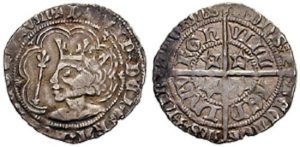
Groat coin from Scotland 1367
History of the groat coin
The Groat coin had a value of 4 pence. The French had a similar coin, which they called ‘Gros Tournois’. It is possible that the silver coin used in England and Ireland originated from this. There was a separate Scottish coin with the same name, which initially had a value of 4 pence, but was later minted as an 8 pence coin. There was also a Scottish version where the coin was worth a shilling.
The coin was initially circulated by Edward I around the year 1280. The coin became popular and enjoyed circulation in England for the next two centuries as the largest silver coin at the time. Eventually, its place was taken by other large coins such as the Shilling introduced by King Henry VII. The coin continued to be minted until the last one, which was made in 1855.
However, mintage was stopped during certain periods. For example, King James I, whose reign was between the years 1603 to 1625, withdrew the mintage. There was also a lull in mintage from 1649 to 1660. These years are better known as the Commonwealth period. However, the Groat was issued as a proof coin twice between 1857 and 1862. In 1888, there was a colonial issue of the coin. Interestingly, the Groat has become a part of The Maundy Set, issued on Maundy Thursday every year by the Queen.
The silver content of the Groat coin
Over the years, the silver content of the coin was slowly reduced. The first English Groat contained 5.8 g of silver. During the reign of Edward III, this fell to 4.7 g and continued to become much less going forward. The Groat issued by King Henry IV had only 3.9 g of silver, which was further reduced to 3.1 g by King Edward IV. It reached 2.1 g by 1559, by which time the purity of the silver contained in the coin had also fallen. After 1561, the coin was withdrawn from circulation for the next hundred years.
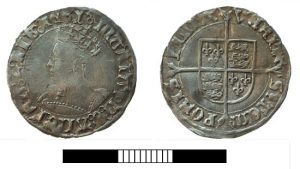
Groat coin found in Oxfordshire
Mintage in later years
Groats were minted only a few times during later years. By this time, it had come to be known as a 4 pence coin. There were a few years mintage after 1786, these years being 1792, 1795 and 1800. The colonial Groat that we discussed earlier, was minted in 1888.
This colonial issue was intended for the countries of British Guyana and the British West Indies, both of which were part of the British Empire at the time. The British Guyana version remained in circulation up to 1955.
Want to find out more about historical coins? Call Physical Gold
Physical Gold is one of the nation’s most reputed precious metal dealers. Our coin experts are best placed to guide you on the purchase of rare and historical coins. If you have such a coin in your possession, it is best to speak to a member of our team for its evaluation. Call us on (020) 7060 9992 or get in touch with us via our website.
Image credits: Wikimedia Commons and Wikimedia Commons
Dieu et Mon Droit – How did the phrase originate?
The origin of the phrase goes back to the time of Richard I, who was descended from French ancestry. King Richard was the King of England from 1189 till his demise in 1199. King Richard used this phrase to announce that it is the divine right of the King, or Monarch to govern.
The phrase was later adopted by King Henry V, as the Royal motto for the Kingdom of England. The phrase now appears on the coat of arms used by the British monarchy. People often wonder how a French phrase could be adopted by the English Royal Family. However, mediaeval England was not the same place that we know now. Norman-French was the language of the English Royal Court at the time. The rulers and the upper classes also spoke this language during that period.
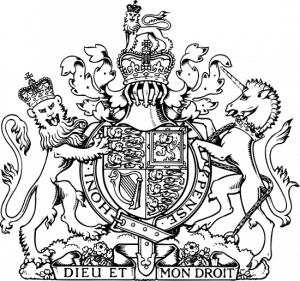
The Royal Coat of Arms
The meaning of the phrase on the coat of arms
When translated, the phrase simply means “God and my right”. Currently, it is the motto of the British Royal Family. A close inspection of the coat of arms used by the British Monarch, reveals that the inscription can be found on a small banner underneath the shield. In the present day, the coat of arms is used by our reigning monarch, Queen Elizabeth II. On the left of the shield, stands the guardian lion wearing the crown of St. Edward. On the right of the shield is a Scottish Unicom. Underneath the shield, there is greenery, with a thistle, Tudor rose and Shamrock. These are representative of the kingdoms of Scotland, England and Ireland. Right below this display is a banner containing the words “Dieu et Mon Droit”.
Where can this coat of arms be seen?
The coat of arms is the official symbol of the British Queen. Therefore, it is clearly visible in every UK court of law, except for the Supreme Court of the United Kingdom and the Magistrate’s Court in the City of London. It is also used on government documents and you might be able to view it on your passport. Globally, this coat of arms is visible on the entrances to UK embassies and consulates.
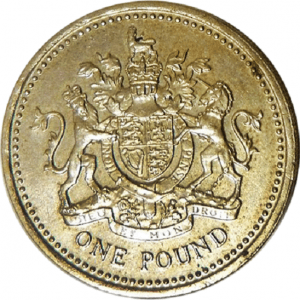
1983 one-pound coin
Appearance on coins
The royal coat of arms has been featured regularly on British coinage, manufactured by the Royal Mint. The most common example of this is the British one pound coin, which has been in circulation since 1983.
By 2008, the Royal Mint had minted a new series of coins with a denomination of 1 pound and below. The full Royal coat of arms appears on the one pound coin with the phrase Dieu et Mon Droit. However, only sections of the coat of arms can be seen on the coins of lower denomination. In 2016, the Royal Mint released a new bimetallic coin called the nations of the crown. Interestingly, an old British coin called the Guinea, which was minted between the years 1663 and 1814 also displayed the royal coat of arms, with the inscription. The coin took its name from the West African nation, Guinea. The gold that was used to mint this coin was sourced from here.
The numismatic experts at Physical Gold can address all your queries related to coins
Collecting coins can be an absorbing hobby, and if the coins are produced from precious metals, they can add tremendous value to your collection. Many collectors and investors have questions related to precious metal coins. Call our coin experts on (020) 7060 9992 or reach out to us via our website and we will be happy to advise you on all your coin purchases.
Image credits: Wikimedia Commons and Wikimedia Commons
Investing in gold and silver coins can be an absorbing passion, as well as a lucrative hobby that allows you to reap rich rewards when you make the right investments. However, when you purchase gold and silver coins, it is extremely important to carry out your transactions through a reputed dealer.
Problems you may face when you buy from a high-street dealer
Buying a precious metal coin is all about ascertaining its authenticity. If you are a layperson, or a hobbyist, the chances are that you may be easily taken for a ride by a pawnbroker or high-street gold dealer. There are several factors to consider. Firstly, you need to be sure about the authenticity of the coin. Next, you should also be able to identify the purity of the metal used to manufacture the coin.
To do this, you will require certain testing equipment. In the absence of proper identification and purity assessment of the coin, you run the risk of being cheated. Additionally, a high-street gold dealer would not have a vast inventory of coins to choose from. More importantly, when you leave the premises of the high-street dealer with your valuable purchases, there is a good chance that you can be targeted for robbery.
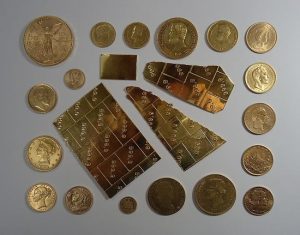
Fine gold and gold coins
Identifying a reputed dealer
If you search on Google for “coin dealers near me”, you will come up with a list of coin dealers based on the geographical area, you are located in. Cross-referencing the list with a reputed industry body like the BNTA can be a great start. The BNTA website publishes a list of affiliated, reputed coin dealers. The first thing you can do on shortlisting these dealers is to give them a call.
A reputed dealer will always answer all your questions openly. No information will be kept hidden from you. Also, you will find that most reputed dealers have a large online catalogue that you can browse through when making a purchase. Lastly, they would offer a buyback guarantee. Needless to say, if a dealer refuses to buy back the gold, they are selling to you, there must be something wrong.
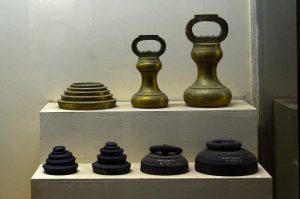
Gold measurement tools from yesteryear
Building a relationship
In order to acquire the best deals on coins, you need to build a steady relationship with the dealer. You need to discuss your buying preferences, specific coins that you are looking for, and a ballpark price that you are willing to pay for them. This will give the coin dealer a good idea of what you’re looking for. So, when an opportunity to purchase a good coin comes up, you’ll be the first to know. It is a mistake to think that the term “coin dealers near me”, simply means that you are limited to small pawnshops, antique vendors, and the like
A reputed online merchant would be able to fulfil your requirements since most of them have a countrywide distribution facility. You would be required to insure your purchases and pay for any shipping logistics. However, this ultimately ensures your safety, and the goods will be securely delivered to your residence.
How a reputed dealer can add additional value
Investing in precious metal coins is also about maintaining divisibility, liquidity, and tax efficiency within your portfolio. Gold coins are free from VAT in the UK and may also be exempt from capital gains tax. A good dealer will be able to advise you on how to create variety in your portfolio while ensuring that liquidity and divisibility are maintained.
Discuss your coin purchases with Physical Gold
At Physical Gold, we take pride in being one of the nation’s most reputed online dealers. Our advisors are always at hand to assist you in your coin purchases. Call us today on (020) 7060 9992 or contact us online via our website.
Image credits: Wikimedia Commons and Wikimedia Commons
British coinage is considered to have one of the richest histories, compared to any nation globally. Our long tradition of Kings and Queens has resulted in one of the world’s oldest coinage systems that have witnessed the reigns of several monarchs over centuries. When we study European coinage, Britain’s history is distinctive and different from the coinage of other European kingdoms and monarchies.
During the 19th century, there were approximately 20 ruling monarchies across Europe. Of course, the currency coins released by many of these monarchs featured a stylised image of the ruler and motif or a coat of arms on the other side of the coin. Now, British coins have had certain peculiarities in the past. These usually consisted of a slogan or a line embossed on the coin. However, who would’ve thought that the German words ‘ich dien’ could appear on a British coin?
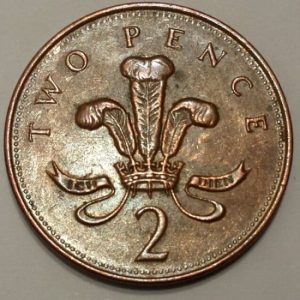
Two pence coin bearing the inscription – ‘ich dien’
What does ‘ich dien’ mean?
Well, the words ‘ich dien’ in the German language literally means ‘I serve’. These words appear on the coat of arms of the Prince of Wales. The words appeared as early as the 14th century, leading to several speculations regarding the origins of the phrase. Interestingly, these words have also been used by Edward the Black Prince. The phrase may have been adopted following an alliance or a meeting with a German monarch, but history has no record of any such event. Therefore, we may never know the exact reason why the phrase ‘ich dien’ was adopted.
The feathers of the Prince of Wales
It is customary for many royal houses to have an insignia or a coat of arms. This creates an identity that can be instantly recognised, much like a logo on a product. The Prince of Wales uses a heraldic badge as the royal emblem. The words ‘ich dien’ is imprinted on the bottom of this badge. However, the phrase was not used only on the emblem. The words ‘ich dien’ can be found imprinted on certain British coins over the years.
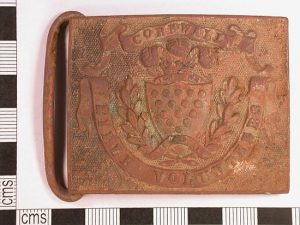
1870 belt plate from Cornwall with the inscription – ‘ich dien’
British coins that carry the words ‘ich dien’
The most commonly found ‘ich dien’ coin is the two pence coin. The words appear on the reverse of the coins of this denomination that were issued between the years 1971 and 2008. Of course, this was not so long ago, and so many such coins can be found in circulation even today. You may have one in your pocket right now!
2008 proof coin celebrating the birthday of Prince Charles
In 2008, his Majesty the Prince of Wales celebrated his 60th birthday. To commemorate this important occasion, a proof coin was minted and released by the Royal Mint. This coin has the words ‘ich dien’ embossed directly on the face of the coin, underneath a stylised image of Prince Charles. This proof coin is of interest to numismatists due to its uniqueness.
Other British coins containing the phrase ‘ich dien’
While the above are examples of recent British coins that contain the German phrase, many other notable coins do so too. The 1811 one penny “Bristol and South Wales” Coin also carries the Prince of Wales’s feathers and the inscription ‘ich dien’. Similarly, there is a British India medal, although officially not a coin in circulation, it carries the words, ‘ich dien’. This medal commemorates the royal visit of King George the fifth to India.
Talk to the coin experts at Physical Gold
Our coin experts are extremely knowledgeable about collectable coins as well as bullion coins. Whether you’re an investor or a collector, you can benefit by giving us a call on (020) 7060 9992. You can also send us an email and we will get in touch with you at the earliest.
Image credits: Wikimedia Commons and Wikimedia Commons
When it comes to coin collecting, every investor will have their own personal set of motivations and reasons for investing. Not every coin collector is a numismatic, (someone who studies coins from a historical, social, or artistic point of view) but they will all have their own set of criteria that determine which coins they wish to invest in.
The motives of a coin collector can vary from being a hobby, for sentimental value or as an investment. The type of coins purchased will differ for each of these types of collectors.
Collector to numismatist
Many numismatists don’t necessarily understand the philosophy of numismatics when they start out. They simply start out by default as a collector. During this period, which often starts at school for many, they come into contact with other collectors and compatriots who are at best interested in the field as a hobby. At this stage, they start trading coins, giving away their duplicate coins in exchange for other coins which they perceive as adding value to their collection. Many understand that their coins may have a certain value at this point in time, as they start to sell off their duplicates and manage to get a fair price for it. Enthused by a monetary angle, in addition to their passion for coins, they start to take numismatics more seriously. For many such numismatists, they start to attend major numismatic events across the country from their late teens to their twenties, gathering knowledge and expertise on the subject of coins.
For those who manage to keep their passion alive through their work lives, they will start formulating their own investment strategies. Through their vast network of contacts, they are able to now source coins of value, as well as identify these gems with a seasoned eye. These numismatists soon start to view precious metal coins as a preferred class of gold investment. Numismatists appear to prefer bullion coins instead of bullion bars, simply due to their passion for coins and banknotes. For some, their passion, in fact, becomes their work, and they align themselves with big-ticket coin dealers and play the dual role of buyer for some and supplier to others.
Evolving your own specialism
Many numismatists start to focus on certain areas of collecting, specialise in these areas and are soon well known for their expertise. For example, many specialise in old coins prior to 1838, often known in numismatic circles as ‘Early Date Gold’. These are typically British and American gold coins which are full of history and are highly sought after by investors and collectors alike. The pre-1838 ones and the pre-1800 ones are difficult to come by and command great value. Of course, apart from the monetary value, there is great joy and satisfaction to be had in the heart of a numismatist when he/she can make a rare ‘find’.
Then there are ‘key date’ coins, based on mintages around certain key historical dates, like the fall of the Berlin Wall, Man on the moon, etc. The key date is represented in the mintmark on the coin. Numismatists often collect key date coins years in advance as part of a set building strategy. Then they play a waiting game for the specific event to gain historic importance. They also capitalise on the scarcity of the coins from these dates as it slowly builds up. A simple example could be the 50p coins that were circulated in the UK to commemorate the London Olympics. At the time, everyone had them, but as the years went by, they have now grown scarcer and are worth a fair bit of money today.
Commemorative coins
Coins that are issued to celebrate a special key date are often known as commemorative coins. A good example from recent times would be the Brexit coin. This commemorative coin is minted in silver as a proof coin by the Royal Mint and marks the date of Britain’s withdrawal from the European Union in 2020. The coin was struck using silver with a purity of 92.5% and had a limited mintage of only 47,000. Since the coin has already been sold out, its value is likely to escalate in the future, as demand for the commemorative coin rises.
Commemorative coins of even greater value can be found within British coinage of the 18th and 19th centuries. For example, the Queen Victoria Jubilee head is a commemorative coin issued in 1887 to celebrate the Queens. Golden Jubilee. Its mintage lasted for only six years, and the coin was last struck in 1893. Similarly, the 1871 Queen Victoria young head Sovereign is also a commemorative coin that celebrates the inauguration of the Royal Albert Hall by the Queen in 1871. These older commemorative coins are now becoming scarce and collectors willing to pay hefty premiums for these commemorative coins in an unscathed, mint condition.
Other thematic specialisms developed by numismatists include collecting proof coinage of the American Civil War. These are hard to come by today and is a coveted area of coin study. Many numismatists who are good at sourcing and have great contacts collect ‘pedigree coins’, i.e. coins owned by someone famous, like a Hollywood film star, royalty, business tycoons, etc. The American gold rush is another historic area of interest for many collectors, as these coins are rare to come by. The San Francisco mint opened in 1854, during this period and many of the gold rush era coinage was struck at this mint.
Coins are bought by certain collectors because the commemorative event or the specific year they were produced may bare a nostalgic value to them. It may represent the year of marriage or birth or signify a specific event such as the Olympics or a sovereign’s anniversary. Most of the World’s commemorative coins were produced from the 1960s onward and have a distinct design with reference to the occasion on which they were issued. Collectors are often not concerned with the resale value it is just a coin that may mean something to them and that they just want to own. They tend to be expensive as they require a high cost of production and usually include a presentation box.
Hobby collectors may be interested in specific dates or releases, where a substantial premium will be added for their uniqueness or appeal. They may be purchasing to complete a set or just because they appreciate the coin for its beauty. Often hobby collectors buy proofs or sets of proofs that may come in a display pack of limited issue, these often have an additional premium which they will find difficult to recoup when they come to sell.
For other collectors, coins are very much an investment. These types of collectors look at coins primarily as a way of making money and hope to profit from particularly rare or hard-to-source coins. Often these investors will methodically research particular dates or mintmarks of rare coins in order to find some defining characteristic that makes them of value. Perhaps there weren’t many coins minted one year? Or there may be a coin has a slight defect leftover from the minting process that makes it unique or of higher value.
Some investors also like to focus on a particular sub-category of coins such as Lincoln cents or Victorian sovereigns. This is partly because investors like to collect complete sets of coins and also because by narrowing their focus to concentrate on a particular area of coins, they can research them in far greater depth.
That’s not all
Some investors look at ancient or very rare coins that bare much larger premiums, up to 200% higher than its intrinsic gold value. The term ‘numismatic coin’ is given to those worth a substantial premium over their simple gold value due to rarity and history. These coins can be bought at auction or from specialist numismatic coin dealers.
Investing in rare and ancient coins is a much riskier investment as the coins are less liquid and their perceived value may be very different from their market value. We do not recommend investing in ancient or numismatic coins unless the purchaser has experience of this market and can afford to potentially wait some time for the right buyer. Gold coins minted pre-1800 and those sold at premiums that exceed 180% of the intrinsic gold value may also be subject to VAT, whereas newer coins (which meet certain criteria) are exempt. In the USA pre-1933 gold is extremely popular as it is non-reportable and non-confiscatable.
Talk to the numismatic experts at Physical Gold
At Physical Gold, our team consists of highly experienced and capable numismatic experts who have great knowledge and experience in the field. Whether you are an amateur hobbyist or an intermediate level numismatist, you would surely gain by having a discussion with our team about your goals as an investor and a collector. Call us on 020 7060 9992 or drop us a line through our website. A member of our team will be in touch with you to have a friendly chat.
Investing in silver coins
Silver coins are a great investment choice if you’re seeking potential capital growth and also want a hedge against falling stock markets and banks. The value of coins tends to rise over time, especially when there’s political and economic instability. Silver coins are also exempt from Capital Gains tax. The modest price of the coins enable accessibility to the market for many compared to gold coins (such as Sovereigns and Britannias), and divisibility to sell part of your holding. The silver price can also rise when demand for industrial silver rises, with its predominant use in electronics.
The industrial demand for silver is rising
The white metal is used extensively in the electronics industry, IT, solar panel manufacturing and a host of other industrial processes. On the other hand, the production of silver from mines has greatly reduced over the years. Rising demand and dwindling supplies have fuelled speculations that there may be a huge price in the spot price of silver in the years to come. Many investors have started buying up silver early with an expectation of making profits, once the prices go up.
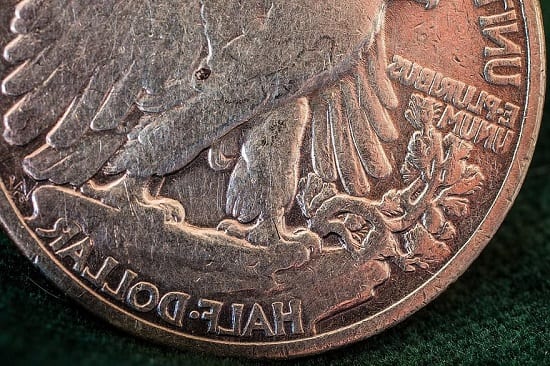
Coins like the silver Dollar do not enjoy tax free status in the UK
Silver to gold price ratio looks enticing
Today, silver is almost a hundred times cheaper than gold. Therefore, it provides investors with easy access to the precious metals market. If you are planning to invest in silver, there could be no better time than the present to take a calculated risk and purchase the white metal. Silver bars and coins can provide you with good investment options if you plan to get in early and wait for the long term to generate good returns. While silver bars allow you to acquire more silver at a cheaper price per gram, silver coins have several distinct advantages.
Variety and purity
Firstly, they are available in a wide variety of sizes. 1-ounce coins are quite common, but now there are larger silver coins of 10 ounces and even up to 1KG. These large coins also offer you the same advantages as buying a silver bar. Secondly, purity is an important consideration. Silver coins with a purity of 95.8% are easily available. However, better options can be found like the Canadian Silver Maple Leaf, which is a coin with 99.9% purity.
A vibrant secondary market
Liquidity is also an important consideration when building a precious metals portfolio. Always buy silver coins that are popular and enjoy a strong secondary market. Obscure and rare coins can be difficult to sell later on. Well-known coins with a vibrant resale market include 1-ounce silver coins like the Krugerrand and the silver Britannia.
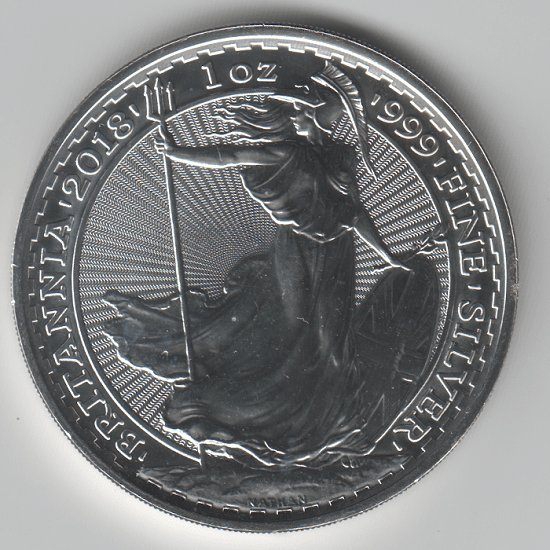
The silver Britannia is one of the finest silver coins to invest in
Tax efficiency
Any investment portfolio needs to be tax-friendly. While coins like the Canadian Maple Leaf are a great buy, the profits you make from their sale are taxable. UK silver coins like the silver Britannia, on the other hand, are CGT free, due to their status as legal tender in the country. The silver Britannia, in particular, is a bullion coin and is available in plenty. Therefore, premiums are low, they are CGT exempt and available with good discounts on bulk orders from reputed silver dealers.
Get in touch with Physical Gold to plan your silver portfolio
Physical Gold is one of the most reputed gold and silver dealers in the UK. Our investment experts can help you identify the right silver coins to buy. Give us a call on (020) 7060 9992 or drop us an email and a member of our team will get in touch with you right away.
Image credits: Pikist and Wikimedia Commons
Proof silver coins as an investment
Investing in silver coins
Silver coins are a popular choice for collectors and investors alike. As many silver coins are legal tender in the UK, they provide an opportunity to invest, without having to carry the burden of Capital Gains Tax (CGT). However, when investing in silver coins, one needs to make the right choice. Silver coins are available as proof sets, bullion coins and rare/ collectable coins.
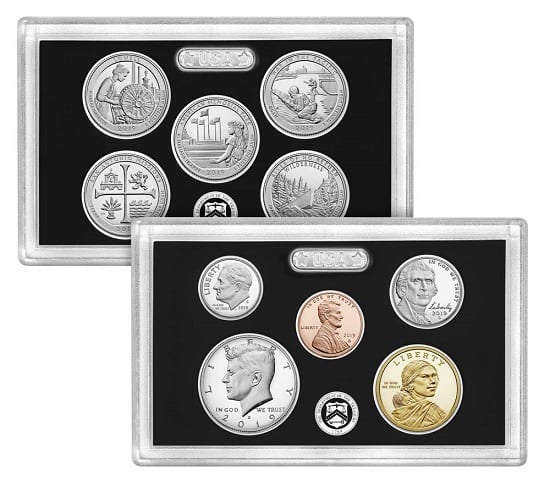
These US Mint proof coins in silver are great for collectors
What are silver proof coins?
Proof coins were originally produced before the actual issue of a coin. They were used for securing approvals from the Ministry of Finance and the administration of the mint. Checking the proof coins is also a method used for verification of the dies used during the production process. Finally, they were retained for archival. Proof coins are usually produced by polishing the dies. This results in a high-quality finish, with a polished look and feel and sharp edges and design. The polished areas of the coin take on an almost mirror-like finish, especially in silver coins. Additionally, the dies used for production are often chemically treated to create a frosty appearance in some areas of the coin.
FREE Guide. Click here to download The Insiders Guide to Gold & Silver Investment
The rising popularity of proof coins
Due to their high-quality finish and attractiveness, silver proof coins have become extremely popular over the years and enjoys healthy demand from the general public. As a result of this, the Royal Mint has been issuing limited edition sets of proof coins. Of course, these coins can be bought at hefty premiums and are usually purchased by numismatists.
Silver proof coins as an investment
If an investment is a primary focus, then buying bullion coins is a better bet. Bullion coins finished to brilliant uncirculated finish are cheaper per gram than a silver proof coin. Most silver dealers will not pay you the same premium when you come to sell the proof silver coin. Proof coins are better suited to collectors or as presents.
The premiums you would pay for buying a proof coin set is more or less the same as that of a commemorative issue. One needs to bear in mind that the higher price being charged for a proof coin is simply on account of production costs and limited availability. This does not change the price of the silver contained within the coin. Bullion coins, on the other hand, are freely available with low premiums. As an investor, you can secure great deals from dealers on bulk purchases of bullion coins. So, if you are buying silver coins as an investment, steer clear of buying silver proof coin sets. Buy current issues of silver bullion coins like the silver Britannia and you can land yourself a much better deal.
Call our silver investment team to discuss your silver coin purchases
Our investment experts offer you free and impartial advice on buying silver coins and bars (such as this 1KG bar). By connecting with the Physical Gold team, you can stay abreast of the latest deals and find out everything you need to know about buying silver coins. Call us today on (020) 7060 9992 or contact us online to speak to a member of the team.
Image Credit: Wikimedia Commons
Benefits of purchasing Silver Britannias
In 1987, the Royal Mint released the gold Britannia coin. These coins were an instant hit and won popularity among collectors and investors. So, to replicate the success of its gold counterpart, the silver Britannia was launched in 1997. At the time of its original issue, the coin had a fineness of 95.8%. In terms of look and feel, the silver Britannia was very similar to its sister coin – the gold Britannia. It featured the Britannia icon, which made the coin instantly recognisable on its reverse.
The coin depicted Britannia as a warrior goddess carrying her trident and shield. The design for the silver Britannia was conceptualised by the well-known designer – Jody Clark. By 2013, the coin was upgraded to 24 carat silver with a fineness of 99.9%. By this time, silver investment had started gaining popularity and the demand for the coin rose significantly.
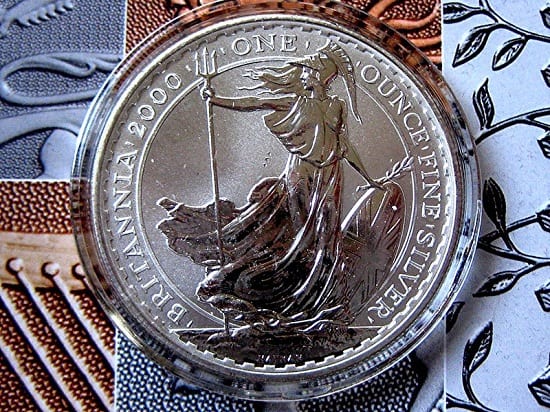
The silver Britannia is a timeless classic
Affordability vs value
Silver Britannias are affordable to buy and store, as they can be bought in tubes of 25 and monster boxes of 500 coins. Since the coin had been released as a bullion coin, they were easily available at very low premiums. Buyers can contact reputed dealers and avail of bulk discounts on their purchases. So, availability and affordability are clearly two benefits that contribute to the popularity of this coin. On the other hand, silver has always been cheaper than gold. It was 85 times cheaper than the yellow metal not too long ago and now, with the global financial crisis deepening, the gap has widened further. Currently, silver is 113 times cheaper than gold, with the ratio touching as high as 125:1 in March 2020. So, this allows investors to have easy access to the precious metals market at a cheaper price point than gold. The silver Britannia coin has made huge gains on the back of this sentiment.
Tax efficiency
As a legal tender coin, any value increases are completely free from Capital Gains Tax. So, UK investors can save a substantial amount in taxes by investing in this coin. Tax awareness is an essential consideration for any investor building a portfolio. The silver Britannia is a clear winner in this case, as the coin offers an opportunity to build a highly tax-efficient silver portfolio.
Liquidity
The silver Britannia is an instantly recognisable, popular coin across the world. Being issued by The Royal Mint, the coins are very liquid and easy to sell worldwide. This is a huge advantage for buyers since the coin can be sold instantly at any point in time, without losing out on market value. The liquidity factor enhances the demand for this coin as for investors who are keen to hold liquid investments that can be converted into cash when the need arises.
Understand the 7 Crucial Considerations before buying Silver Britannias. Click here
Divisibility
The silver Britannia is also available in different weights and sizes. There are special anniversary editions as well. This contributes to variety and divisibility – two more important benefits of owning the silver Britannia. Variety adds to the value of the coin, while divisibility allows investors to plan their sales and sell off small portions of their silver investments at a desirable market price.
Get in touch with us for guidance regarding your silver investments
At Physical Gold, we have a team of silver experts who can assist you in making the right purchasing decisions, when it comes to buying silver coins, as well as gold coins. Call us today on (020) 7060 9992 or get in touch with our team online to get the best deals on silver Britannias.
Image Credit: Eric Golub
Silver Britannia value
The silver Britannia has been around since 1997. The coin had a fineness of 95.8% during its original issue. It was a 1-ounce silver coin that mirrored the design and elements of the original gold Britannia, which was launched 10 years earlier. Due to the popularity of the gold Britannia, the Royal Mint decided to start minting the same coin in silver. By 2013, the purity of the silver Britannia had been increased to 99.9%. This was basically 24 carats fine silver with a purity of 999.9. Needless to say, the coin became extremely popular. It was easily available and its sales skyrocketed.
Design elements
The silver Britannia features the classic image of the Britannia icon on its reverse. This is a classic British icon, which may have originally been conceived as early as Roman times. Britannia is shown as a goddess warrior carrying a shield and a trident. The image represents the spirit and bravery of the people of Britain. The design of the silver Britannia was created by Jody Clark. The coin features an image of our reigning Queen, Elizabeth II on its obverse.
There have been changes in design across different issues of the coin, in different weights and dimensions. In some issues, we can see the warrior riding a chariot, or sitting with a lion. Some coins feature close-ups and other design elements. The Royal Mint has also minted numerous special editions of the coin, including one which features an oriental border and the 30th-anniversary edition in 2017. All of these are popular with investors and collectors alike.
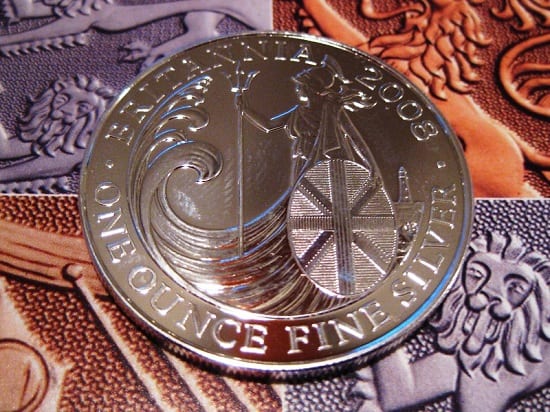
This silver Britannia coin from 2008 shows the Britannia icon with a shield
The value of the coin
The value of this coin is primarily based on the underlying silver price. Unless the coin is a collector’s edition, the Britannia coins can be sold for around or just under the 1oz silver spot price. The silver spot price can rise and fall daily and is linked to 30th-anniversary variables which affect the supply, demand and ultimately price of silver. Since the coin is mass-produced and available easily, premiums are extremely low. In addition to this, good discounts are available from many dealers on bulk purchases. This allows investors entry into the precious metals market at a low price point.
Moreover, there are predictions that the price of silver may go up in future. The demand for silver is rising due to several industrial applications. At the same time, the production of silver has fallen over the years. These factors lead experts to believe that a price rise is imminent. If this happens, investors who have purchased silver Britannia coins today could make a windfall gain.
A tax-efficient investment
Another factor that adds to the value of silver Britannias is its tax efficiency. As the coin is legal tender in the UK, they are capital gains tax exempt. This means that substantial tax savings can be generated when booking profits during the sale of your investment. Clearly, it increases the value of the coin.
Call our silver experts to receive guidance when buying these coins
The silver Britannia presents an excellent investment opportunity to acquire 1 ounce of pure silver at a great price point. There are many other versions with a variety of that dimensions, including fractional issues that can be purchased. Call our silver experts at Physical Gold Limited today on (020) 7060 9992 or drop us an email if you’re interested in investing in silver Britannia coins.
Image Credit: Eric Golub

